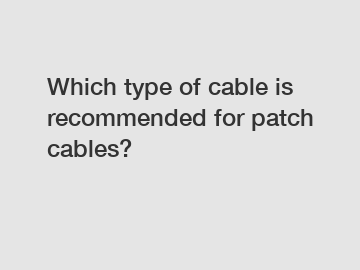Feb. 03, 2024
Electrical Equipment
Which Type of Cable is Recommended for Patch Cables?
In today's digital age, connectivity plays a crucial role in our daily lives. From our homes to offices, from data centers to telecommunication networks, the demand for efficient and reliable networking solutions is constantly increasing. One essential component of any network infrastructure is patch cables, which are used to connect devices within a local area network (LAN). However, choosing the right type of cable for patching is crucial to ensure optimal performance. In this article, we will explore the different types of cables recommended for patch cables and their respective benefits.
Category 5e (Cat 5e) Cable:

Category 5e (Cat 5e) cable is one of the most commonly used cables for patching. It is an enhanced version of the older Category 5 (Cat 5) cable and offers improved performance. Cat 5e cables are capable of transmitting data at speeds up to 1000 Mbps and have a bandwidth of 100 MHz. These cables are suitable for most Ethernet applications and are widely used for patching in homes and small to medium-sized businesses. Cat 5e cables provide excellent performance for voice, data, and video applications.
Category 6 (Cat 6) Cable:
Category 6 (Cat 6) cable is an advanced version of Cat 5e cable and is designed to support higher bandwidth and faster data transmission. Cat 6 cables have a bandwidth of 250 MHz and offer transmission speeds up to 10 Gbps over a short distance. These cables are ideal for high-density environments such as data centers and enterprise networks. Cat 6 cables are also backward compatible with Cat 5e and Cat 5 cables, making them a versatile choice for various applications.
Category 6a (Cat 6a) Cable:
Category 6a (Cat 6a) cable is an enhanced version of Cat 6 cable and provides even higher performance. Cat 6a cables have a bandwidth of 500 MHz and can support data transmission speeds up to 10 Gbps over a longer distance compared to Cat 6 cables. They are commonly used in applications requiring extended reach, such as larger office buildings and campus networks. Cat 6a cables offer superior noise and crosstalk reduction, ensuring reliable performance in high-interference environments.
Fiber Optic Cable:
Fiber optic cables are the go-to choice for high-speed, long-distance data transmission. These cables use light signals to transmit data instead of electrical signals, resulting in higher bandwidth and better immunity to electromagnetic interference. Fiber optic patch cables are available in various types, such as single-mode and multimode, each catering to specific needs. Single-mode fiber cables are designed for long-distance transmission, while multimode fiber cables are suitable for shorter distances. Fiber optic cables are common in telecommunication networks and data centers, where high-speed and reliable connections are essential.
Closing Paragraph:
When it comes to patch cables, the choice of the right cable depends on the specific requirements of the network. For most applications, Cat 5e or Cat 6 cables would suffice, providing reliable performance and fast data speeds. However, for more demanding environments or longer distances, upgrading to Cat 6a or fiber optic cables would be recommended. It is essential to consider factors such as bandwidth, transmission speed, and interference when selecting the appropriate cable for patching needs. Seeking advice from networking professionals or reputable suppliers can help ensure the best cable choice for a particular network setup.
For more information or assistance in selecting the right patch cables for your network, please contact us. We are here to help you maximize your network's performance and connectivity.
If you are looking for more details, kindly visit odf 4 core, ST LC Patch Cord, Audio patch cords.
Previous: What is limit switch introduction?
Next: What are the advantages of using CNLINKO LP-20 connectors for hassle-free B2B purchase?
If you are interested in sending in a Guest Blogger Submission,welcome to write for us!
All Comments ( 0 )